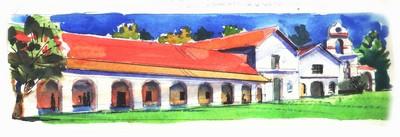San Juan Bautista will appeal to Nevadans who love history

Nevadans curious about the history of the Old West love to find threads that intertwine in the fabric of the past. They find such threads in places like San Juan Bautista, Calif., a town that grew up around the mission established by Spanish Franciscans in 1797. Woven into the colorful historical tapestry of the old town are figures with Nevada connections.
Now a quiet little town just off U.S. 101 on Highway 156 west of Hollister, San Juan Bautista nestles into a lovely valley. It’s grid of streets contains remnants of several periods of California history beginning with pre-Spanish times when the Mutsun people, a culture of hunters and food-gatherers, built small villages. The mission church complex, the Camino Real, the Indian cemetery and early adobe buildings represent Spanish Colonial times. Across the street, buildings preserved in San Juan Bautista State Historic Park represent the era of Mexican and later American control of California. A walking tour downtown reveals many more venerable reminders of a colorful past.
The long building adjacent to the church dates from establishment of the mission by Catholic fathers in the late 1700s, 15th in the string of 21 missions founded in California. Situated a day’s walk from missions at Carmel and Santa Clara, San Juan Bautista had rich soil, plenty of water, nearby sources of timber and stone, and a handy work force in the native people.
Construction of the largest church in the mission chain began in 1803. In continuous service since 1813, the church at San Juan Bautista remains standing despite many earthquakes, with a few visible cracks to show for the shaking. Stones of its floor bear deep indentations and a smooth sheen from the shoes of the faithful over the past 200 years. On the altar wall note the colorful painting done by Thomas Doak, a sailor who left his ship to become the first United States citizen to settle in Spanish California.
Mexican control of California brought civil administration to the missions. In San Juan Bautista, Jose Tiburcio Castro became administrator with the decree to divide and disperse the properties. The order benefited his many relatives and friends. He renamed the town San Juan de Castro.
In 1838, his son Jose Antonio Castro, Prefect of the northern half of Alta California, ordered construction of an adobe building in the town intended to serve as his headquarters, located on the plaza near the mission and church.
In 1843, Jose Antonio Castro used San Juan as a base to rally support for the military overthrow of the Mexican governor of California. Later in command of all Mexican military forces in California, Castro felt growing pressure from the flood of immigrants flowing into California. This led to a contest of wills with John D. Fremont, whose mapping expeditions of the interior of the West in the 1840s, including Nevada, lent impetus to the westward movement.
Castro allowed Fremont and his party of “surveyors” to stay in California for the winter of 1845-46, if they stayed away from coastal settlements. Defying Castro, Fremont showed up at San Juan, occupied a hill overlooking the town and exchanged barbs with Castro. Fremont finally left, heading north toward Oregon, but returned when a courier brought news of the impending Bear Flag Rebellion. In San Juan Bautista as a lieutenant colonel, Fremont mustered a force of 428 men known as the California Battalion, which helped take control of California.
The ill-fated Donner Party reached the Sierra Nevada too late to safely cross and got trapped in deep snow just 30 miles from today’s Reno in 1846. The starving immigrants resorted to cannibalism to survive. Survivors included the 10-member Breen family. The Irish Catholic family arrived penniless at the San Juan Bautista mission. In 1848, one of the sons headed for the newly discovered Mother Lode near Sutter’s Fort.
He returned with $12,000, a fortune which allowed the family to buy the Castro adobe and headed them toward prominence in the area.
This adobe now comprises part of the state park, which also includes a two-story 1858 hotel, an older adobe residence and a stable from the 1870s full of horse-drawn vehicles. The park remains open all year from 10 a.m. to 4:30 p.m.
Margo Bartlett Pesek’s column runs on Sundays.